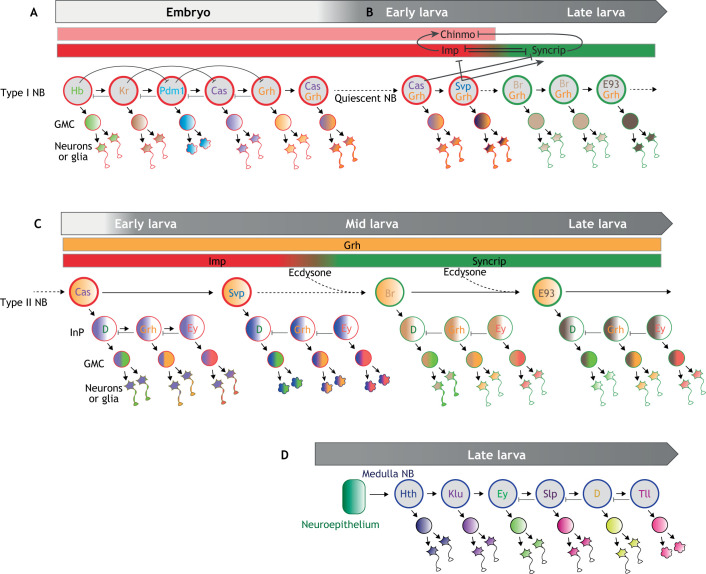Fig. 1.
Temporal patterning systems in Drosophila NBs. (A) Type I NBs divide asymmetrically to self-renew and generate GMCs. The latter divide usually once, giving rise to two post-mitotic progeny: neurons or glia. Embryonic NBs in the ventral nerve cord sequentially express a series of ‘temporal’ transcription factors (tTFs) (Hb→Kr→Pdm1→Cas→Grh). Progression throughout the sequence is driven by transcriptional cross-regulatory interactions between tTFs. Sequential expression of tTFs ensures the production of daughter cells with different fates by the same NB. Co-expression of two temporal factors (e.g. Cas and Grh) can create novel temporal windows. (B) A subset of NBs enters quiescence by the end of embryogenesis and resumes divisions in early larvae. Cas and Svp are sequentially expressed to promote a switch in the expression of Imp and Syncrip, thereby creating two large post-embryonic temporal windows (Imp+ and Syncrip+, respectively). The late Syncrip+ window is subdivided into two subtemporal windows marked by the expression of Br and E93. (C) Type II NBs in the central brain generate intermediate progenitors (InPs) that divide a few times and exhibit their own temporal patterning system (D→Grh→Ey). Concomitant progression of two distinct temporal patterning systems in larval NBs and their InPs increases neural diversity in large lineages. Ecdysone signaling facilitates the Imp-to-Syncrip transition and promotes the expression of E93 (and possibly Br). (D) Medulla NBs are converted from a neuroepithelium in the larval optic lobes. They express another series of tTFs (Hth→Klu→Ey→Slp→D→Tll) to specify the identity of their progeny. GMC, ganglion mother cell; InP, intermediate progenitor; NB, neuroblast.

